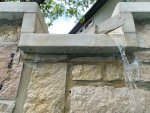We recently had our pool and spa rebuilt. During the spa rebuild we replaced a jurassic park-esque waterfall feature with a simple stone spillway. When the builder asked how wide I wanted the spillway my mind started to wonder about the pump, pump speed, gallons of water per minute on each setting and the speed needed to ensure that at the lowest speed setting, water would have enough velocity to cascade over the spillway and not roll down the front of the rocks like my neighbors (which was cover in water deposits). Since the pool was drained at the time of rebuild, and I didn't go to Yale and study mathematics and fluid dynamics, I made an estimated width with my two hands and we were off to the races.
Fast forward 12 months and now we have water deposits over the front of the rock of the spa. The spillway drips around the edge of the spillway and under and spills down the face of the rocks. My greatest fear realized. (See photos)
Now I am trying to figure out how to solve. Options from 3d printing something clear to affix to the front edge to eliminate drip and consolidate flow, replacing the stone inside to reduce the width of the opening reducing size and thus speeding up flow? (venturi effect?) - See sample photo with reduce/blocked flow - Not great either. When the pump is running at 3K+ RPM the flow is sufficient to cascade over the spillway and mostly clear the stone (but some water still drips underneath and goes down the face of the rock). I would prefer not to run the pump on full speed as it is not needed and uses electricity.
This doesn't seem like is should be so complex. Any suggestions are greatly appreciated.
Thanks!
Ryan
Fast forward 12 months and now we have water deposits over the front of the rock of the spa. The spillway drips around the edge of the spillway and under and spills down the face of the rocks. My greatest fear realized. (See photos)
Now I am trying to figure out how to solve. Options from 3d printing something clear to affix to the front edge to eliminate drip and consolidate flow, replacing the stone inside to reduce the width of the opening reducing size and thus speeding up flow? (venturi effect?) - See sample photo with reduce/blocked flow - Not great either. When the pump is running at 3K+ RPM the flow is sufficient to cascade over the spillway and mostly clear the stone (but some water still drips underneath and goes down the face of the rock). I would prefer not to run the pump on full speed as it is not needed and uses electricity.
This doesn't seem like is should be so complex. Any suggestions are greatly appreciated.
Thanks!
Ryan





